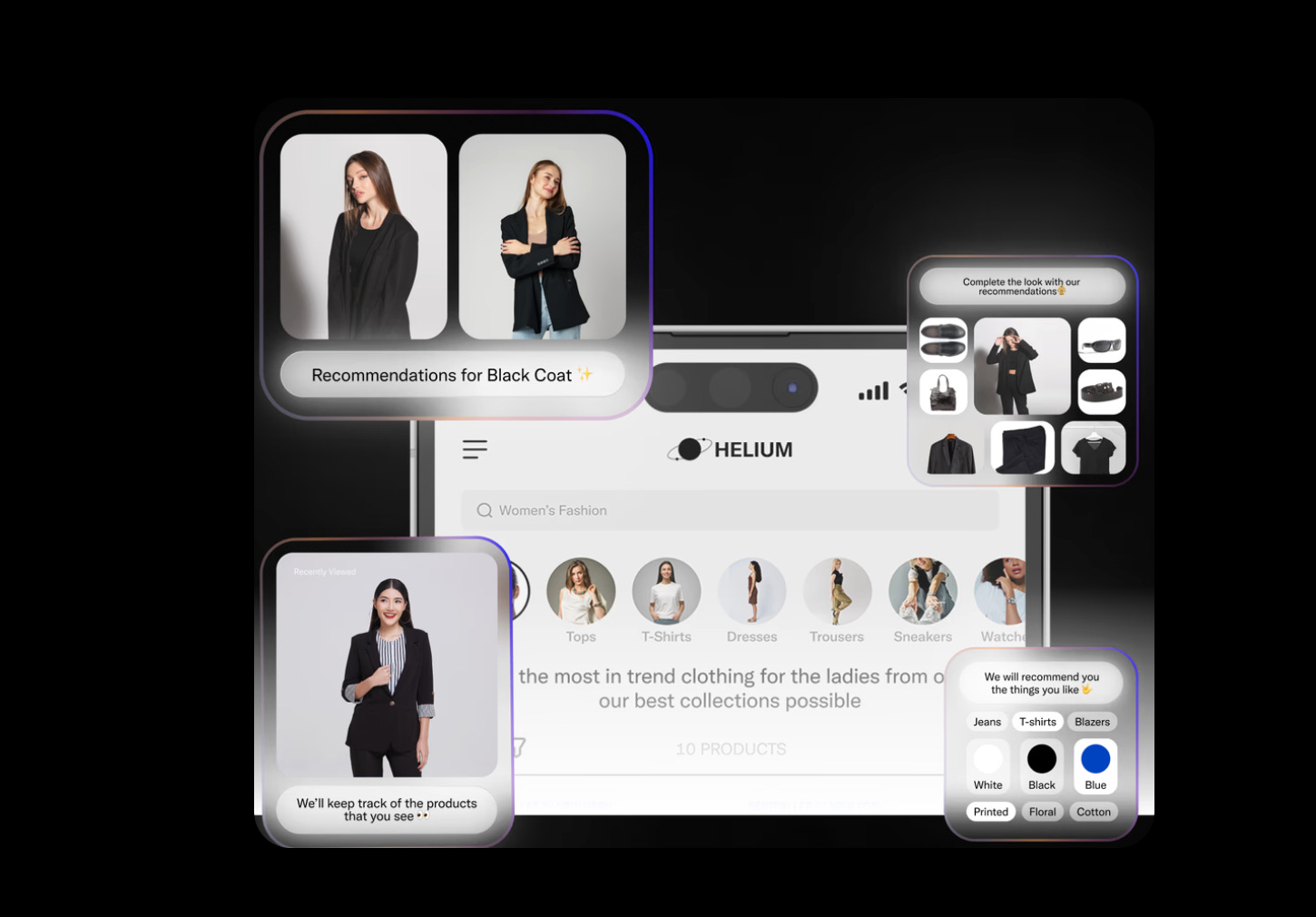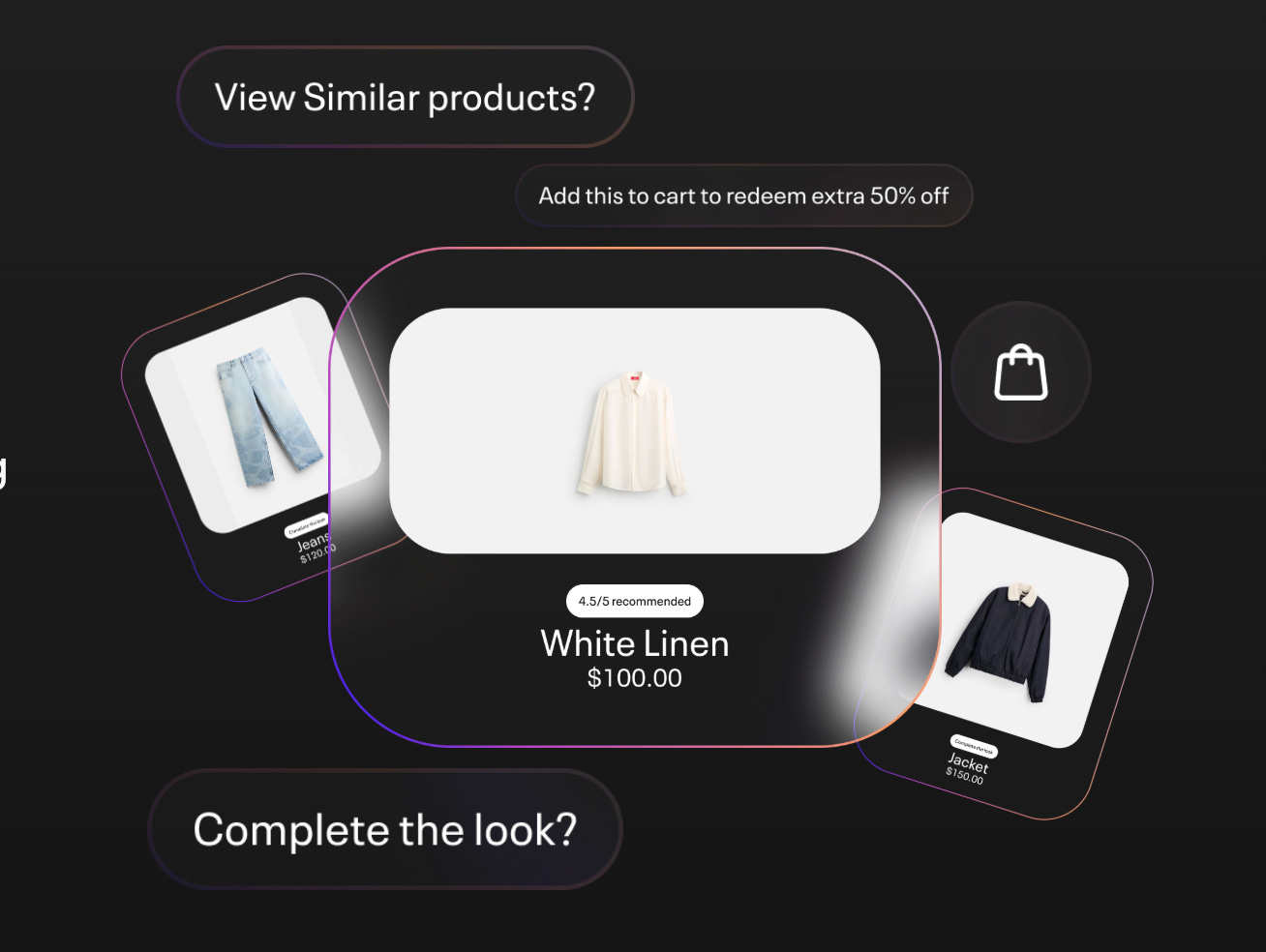How AI is Improving Product Recommendations in Retail and Driving Higher AOV
Want to see how AI-powered recommendations drive higher AOV? Learn best practices, proven tactics, and case study results from leading ecommerce brands.
Customer acquisition costs aren’t slowing down. Traffic gets more expensive every quarter, and chasing new users can feel like burning through margin. That’s why your existing shoppers hold the biggest opportunity: if every order grows larger, revenue efficiency improves instantly.
Average order value (AOV) is where most brands leave money on the table. Static bundles, discount pushes, and “related items” carousels rarely shift the basket. They either feel irrelevant or erode trust.
AI-powered product recommendations flip that equation. By reading live intent—what style a shopper leans toward, what price bands they’re comfortable with, how close they are to a decision—they can nudge baskets higher without friction.
Why traditional recommendation engines don’t work
Most ecommerce stores still rely on outdated recommendation engines. They look smart on the surface, but fail where it matters: driving conversions and bigger baskets.
Here’s why:
Generic “related products” get ignored: Shoppers don’t trust carousels filled with random items. They want personalized product recommendations that actually reflect their intent, not just what others clicked.
Static bundles miss the moment: A festive buyer looking for occasion wear shouldn’t see office basics. Without context, upsells and cross-sells stay irrelevant.
Irrelevant upsells lower trust: When shoppers are pushed into add-ons that don’t match their session behavior, it feels like a cash grab. This results in lower AOV and higher bounce.
No session-level intelligence: Traditional tools can’t capture real signals like price comfort, decision speed, or style affinity. Without session-level intelligence, you can’t move from generic personalization in ecommerce to precise AI-powered recommendations that actually close the sale.
How AI-powered product recommendations increase AOV
Shoppers don’t spend more because you add another carousel. They spend more when your store reads their intent and suggests products that fit the moment. With AI ecommerce personalization, every upsell and cross-sell is grounded in live behavior and catalog signals, which leads to higher acceptance and a bigger basket size.
Some ways that AI-powered product recommendations increase AOV are:
Contextual cross-sells that make sense
Static cross-sells fail because they ignore context. AI product recommendations use catalog metadata and live browsing signals to surface accessories that fit the occasion and shopper intent. For example:
Festive wear browsers see jewelry, footwear, and dupattas styled for celebration.
Office wear browsers see muted blazers or structured handbags that fit weekday personas.
This shift drives immediate revenue impact: brands running contextual cross-sells through AI suggestions reported up to 30% more converted sessions.
Smart upsells aligned with shopper profile
Upsells increase AOV only if they match the shopper’s willingness to pay. AI based product recommendation models analyze price comfort signals—ranges viewed, ignored, or repeatedly toggled—before showing a premium option.
For example, if a shopper consistently engages with products in the ₹4,000–₹6,000 band, the engine introduces premium variants within that range. Similarly, if browsing signals show hesitation in higher bands, the system suppresses premium nudges to protect the cart.
Leading brands like W for Woman have used Pulse to implement this price-sensitive upsell logic and saw a 6% uplift in AOV from higher-quality baskets.
Adaptive recommendations on PDP and cart pages
Traditional systems treat PDPs and carts as static surfaces. AI suggestions adapt in real time based on whether the shopper is still evaluating or ready to buy.
During comparison (review scanning, size toggles), substitutes are shown to accelerate the decision.
Once the shopper shows decisive signals (fast add-to-cart, shorter dwell), complements appear to expand the basket.
This adaptive sequencing drives measurable revenue. For example, Alchemy Fine Home saw a 25% AOV uplift after they used Pulse to switch from static carousels to contextual PDP recommendations.
Dynamic cart expansion nudges
Cart is the final chance to grow AOV. Static bundles often feel forced, but AI ecommerce personalization generates nudges from real co-purchase and style signals.
Sneakers trigger socks and caps that match the look and budget.
Sofas surface cushions and throws aligned with design metadata.
Culture Circle used this approach, running cart-level cross-sells styled for each shopper. This resulted in a 12% increase in AOV alongside a 12% conversion lift.
Best practices for implementing AI recommendations
Getting value from AI ecommerce personalization is not about switching on every feature at once. It’s about sequencing the rollout so each step drives measurable revenue. Here’s how to approach it:
Start with PDP recommendations
Product detail pages are the easiest entry point for personalized product recommendations. They carry high intent, and even small improvements in substitutes or complements lead to noticeable uplifts. Many brands report double-digit AOV growth by first replacing static “related products” with AI powered recommendations on PDPs.
Layer AI cross-sells in cart and post-purchase
Once PDPs are optimized, expand to cart and post-purchase flows. Cart is the most underutilized surface for AI product recommendations because static bundles feel forced. By layering dynamic, session-aware cross-sells, you can expand baskets without harming conversion. Post-purchase flows are equally valuable—nudges to accessories or refills increase lifetime value.
Use session signals, not demographics
Demographics alone create stereotypes and generic results. Generative AI personalization thrives on session-level signals like:
Style affinity (neutrals vs brights)
Price comfort (ranges browsed vs ignored)
Trust cues (time spent on reviews, size charts, or delivery policies)
By weighting these signals, your AI based product recommendation engine delivers context-driven suggestions that increase AOV without alienating the shopper.
Continuously A/B test recommendation placement and mix
No two catalogs or customer journeys behave the same. Test placement (above fold vs below, PDP vs cart) and mix (substitutes vs complements) to find what moves AOV without harming conversion. AI suggestions can auto-adapt, but human oversight through structured testing is what locks in sustainable wins.
Smarter recommendations, higher revenue
Most ecommerce sites still rely on cosmetic recommenders. They show “related products,” but don’t adapt to session intent, so AOV stays stagnant.
Helium Pulse changes that. It captures 20+ live signals in every session (price comfort, style affinity, trust cues, decision speed), and feeds them into its recommendation engine. That means:
PDP recommendations switch between substitutes and complements depending on decision state.
Upsells appear only when browsing behavior shows comfort in higher price bands.
Cart nudges are built from co-purchase and catalog signals, not static bundles.
That’s why brands running AI ecommerce personalization see double-digit AOV lifts—not from discounts, but from relevance that compounds basket size.
Book a demo to see how Helium Pulse powers AI recommendations that grow cart size and revenue.




